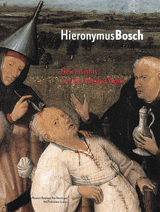
Willemsen 2001
“Playing with Reality. Games and Toys in the Oeuvre of Hieronymus Bosch” (Annemarieke Willemsen) 2001
[in: Jos Koldeweij, Bernard Vermet and Barbera van Kooij (eds.), Hieronymus Bosch. New Insights Into His Life and Work. Museum Boijmans Van Beuning-NAi Publishers-Ludion, Rotterdam, 2001, pp. 192-199]
Bosch was the first to develop the motif ‘games and toys’, which had already appeared in the Netherlands earlier (in drawings and illuminated manuscripts), on a grand scale. The toys that are used by Bosch’s children, adults and devils, are faithful representations of the toys that were in use in his days.
The playing cards, dice and backgammon board in the lower section of the right wing of the Garden of Delights had been symbols of sin in art and literature for ages. The wooden skates with iron blades on the same wing and on the left wing of the St. Anthony triptych (Lisbon) (see the diabolical messenger) really existed around 1500, as has been proven by excavations. On the backside of the Vienna Carrying of the Cross wing we see a child with a toy windmill and a walking frame. According to Gibson the toy windmill corresponds with the cross on the other side of the panel and the whole scene is a prefiguration of the carrying of the cross. Then again, the two scenes (the child and Christ carrying the cross) could never be seen at the same time. Perhaps the other (now lost) wing also showed a child with a toy windmill, resulting in a playful battle between two children with toy windmills, as can be seen on an engraving by Israhel van Meckenem.
A toy windmill and a walking frame (but of another type) can also be seen on the right wing of the Lisbon Temptations of St. Anthony. The devil in this walking frame, who is dressed like an old man, has been depicted with three attributes that are typical of children: the toy windmill, the walking frame and also a feeding bottle for babies. On the Bruges Last Judgment triptych a toy windmill is protruding from the behind of a figure who is bending forward.
On the closed wings of the Lisbon St. Anthony three children are watching Christ carrying the cross. They are carrying a toy windmill and a kolf club (kolfstok). The children presumably represent the mocking crowd that gathered to watch Christ: laughing children, sometimes with toys, can also be seen in other illustrations of the Carrying of the Cross. In the Gula scene of the Prado Tabletop with the Seven Deadly Sins we see a kolf club and a little ball in the neighbourhood of a child: apparently this child is more interested in drinking than in playing, and thus Bosch portrays it as a little glutton. Around 1500 kolf (kaatsen) was by far the most popular game.
On the Conjuror panel we see a man playing thimblerig and a hoop. A child with a toy windmill focuses the spectator’s attention on the point of the narrative: the purse that is being stolen. In the works of Bosch’s sixteenth-century imitators we also see playing cards, backgammon boards, toy windmills and skates but here they are depicted in a less meticulous way than with Bosch. This could provide us with a key for the attribution of paintings to Bosch or to his followers.
In Bosch’s iconography and in that of Netherlandish manuscript illustrators and printmakers toy windmills, walking frames and kolf clubs were always associated with children, whereas playing cards alluded to frivolous squanderers. Whenever archaeological excavations enable us to compare toys that Bosch painted to a real specimen, we can conclude that his representation of these artefacts was very true-to-nature, although they often appear in a fantastic context. Bosch was a supreme master when it came to playing with reality.
[explicit]